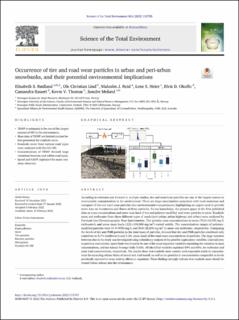| dc.contributor.author | Rødland, Elisabeth Strandbråten | |
| dc.contributor.author | Lind, Ole Christian | |
| dc.contributor.author | Reid, Malcolm James | |
| dc.contributor.author | Heier, Lene Sørlie | |
| dc.contributor.author | Okoffo, Elvis D. | |
| dc.contributor.author | Rauert, Cassandra | |
| dc.contributor.author | Thomas, Kevin V | |
| dc.contributor.author | Meland, Sondre | |
| dc.date.accessioned | 2022-03-24T12:06:25Z | |
| dc.date.available | 2022-03-24T12:06:25Z | |
| dc.date.created | 2022-02-22T08:59:39Z | |
| dc.date.issued | 2022 | |
| dc.identifier.citation | Science of the Total Environment. 2022, 824 . | |
| dc.identifier.issn | 0048-9697 | |
| dc.identifier.uri | https://hdl.handle.net/11250/2987344 | |
| dc.description.abstract | According to estimates put forward in multiple studies, tire and road wear particles are one of the largest sources to microplastic contamination in the environment. There are large uncertainties associated with local emissions and transport of tire and road wear particles into environmental compartments, highlighting an urgent need to provide more data on inventories and fluxes of these particles. To our knowledge, the present paper is the first published data on mass concentrations and snow mass load of tire and polymer-modified road wear particles in snow. Roadside snow and meltwater from three different types of roads (peri-urban, urban highway and urban) were analysed by Pyrolysis Gas Chromatography Mass Spectrometry. Tire particle mass concentrations in snow (76.0–14,500 mg/L meltwater), and snow mass loads (222–109,000 mg/m2) varied widely. The concentration ranges of polymer-modified particles were 14.8–9550 mg/L and 50.0–28,800 mg/m2 in snow and meltwater, respectively. Comparing the levels of tire and PMB particles to the total mass of particles, showed that tire and PMB-particles combined only contribute to 5.7% (meltwater) and 5.2% (mass load) of the total mass concentration of particles. The large variation between sites in the study was investigated using redundancy analysis of the possible explanatory variables. Contradictory to previous road studies, speed limit was found to be one of the most important variables explaining the variation in mass concentrations, and not Annual Average Daily Traffic. All identified variables explained 69% and 66%, for meltwater and mass load concentrations, respectively. The results show that roadside snow contain total suspended solids in concentrations far exceeding release limits of tunnel and road runoff, as well as tire particles in concentrations comparable to levels previously reported to cause toxicity effects in organisms. These findings strongly indicate that roadside snow should be treated before release into the environment. | |
| dc.language.iso | eng | |
| dc.title | Occurrence of tire and road wear particles in urban and peri-urban snowbanks, and their potential environmental implications | |
| dc.type | Peer reviewed | |
| dc.type | Journal article | |
| dc.description.version | publishedVersion | |
| dc.source.pagenumber | 11 | |
| dc.source.volume | 824 | |
| dc.source.journal | Science of the Total Environment | |
| dc.identifier.doi | 10.1016/j.scitotenv.2022.153785 | |
| dc.identifier.cristin | 2004349 | |
| dc.relation.project | Norges forskningsråd: 223268 | |
| dc.relation.project | Norges forskningsråd: 160016 | |
| cristin.ispublished | true | |
| cristin.fulltext | original | |
| cristin.qualitycode | 2 | |
